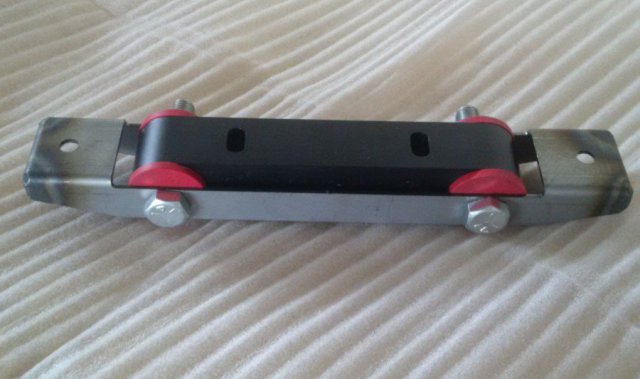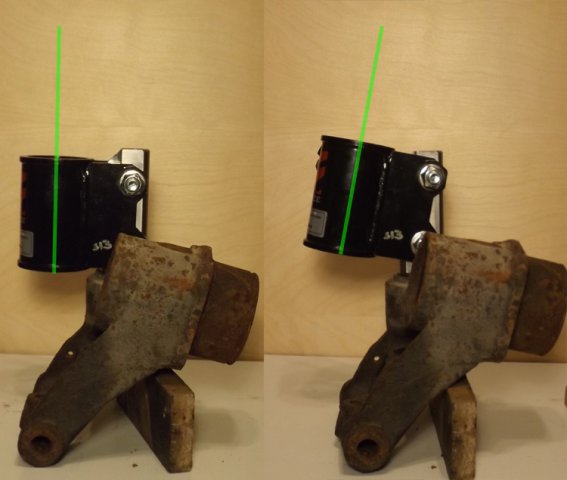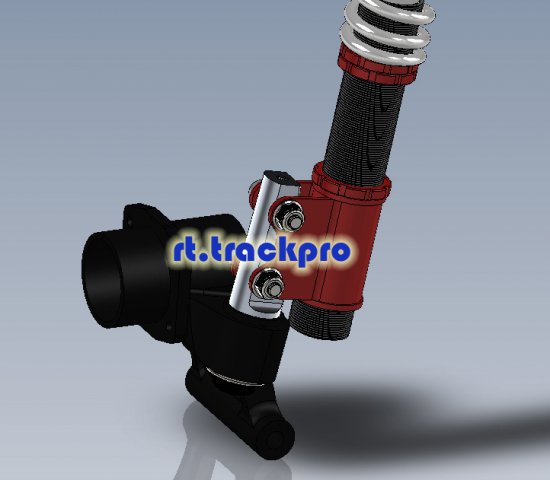
G-E
Members-
Posts
222 -
Joined
-
Last visited
-
Days Won
1
G-E last won the day on December 21 2014
G-E had the most liked content!
Contact Methods
-
Website URL
http://responsetype.com
Profile Information
-
Location
Toronto
G-E's Achievements
Newbie (1/14)
4
Reputation
-
240Z+ poly transmission mount development
G-E replied to G-E's topic in Brakes, Wheels, Suspension and Chassis
The current prototype... modified to use 5/8" bolts directly, without the sleeves on the Z31 mount, this saves some cost. -
best adjustable coil overs for daily driving?
G-E replied to bawfuls's topic in Brakes, Wheels, Suspension and Chassis
Why don't you put more batteries up front? Spread the weight a little?- 17 replies
-
- suspension
- springs
-
(and 1 more)
Tagged with:
-
240Z+ poly transmission mount development
G-E replied to G-E's topic in Brakes, Wheels, Suspension and Chassis
Final price would hinge on the bracket cost, really $130+bracket at this point. This style of bushing is captive and should be much stiffer than the oem style cup isolator, and with the height adjustment, there should be more room available for say r30a swaps... If anyone wants to volunteer to be a test mule, please chime in or pm. -
240Z+ poly transmission mount development
G-E replied to G-E's topic in Brakes, Wheels, Suspension and Chassis
It's not luck I need... I asked questions. -
240Z+ poly transmission mount development
G-E replied to G-E's topic in Brakes, Wheels, Suspension and Chassis
As per second last paragraph, <$200USD. Replacement bushings would be around $40-45. -
240Z+ poly transmission mount development
G-E replied to G-E's topic in Brakes, Wheels, Suspension and Chassis
Is that really your question? They are height adjustable. They are slotted for fine tuning. They are stiffer. They are lighter. They will not tear. They look snazzy. -
Alright, it's been a while since I've upset the status quo around here, so let me begin by saying, I hope to have these ready to offer by mid-march if there's enough interest. Due to the fact that they are using components from an existing kit (300ZX trans mounts) there is minimal work required, but questions remain. Firstly, the bushings are offset, putting the majority of compressive material above the bushing sleeves on the 300ZX kit, and like the 300ZX kit, we would be ditching the upper C-shaped isolator that attaches to the OEM bracket which is a lot softer. However, because of driveline swaps, I don't know how much height adjustment would be ideal for a s30's, the bushings can be rotated to a position 8mm lower (4mm offset eye = +4/-4), but shims or washers can be used on top. The 300ZX kit comes with 4mm shims (optionally) but standard washers are approximately 2mm thick, and would be a cheaper option if significant height isn't needed. The included photos show the potential change on the baseline height, but because the OEM mount sits funny and the upper isolater is deformed, it's hard to get a perfect comparison. If anyone can provide accurate face offsets from the bracket to the isolator top on a new bushing, I would appreciate it. Secondly, as you can see, the shape would be somewhat different, there is more stuff hanging down to the sides, and less in the middle, I'm concerned this might affect exhaust clearance? Some expert feedback welcome here as well. Assuming everything checks out, there's a third possible question here: offering plain brackets without the seams welded (as shown), as opposed to welded and powder/e-coated could be an option, what are your opinions on that if it saves money? Likewise, what's a fair price with weld+paint? I've seen some very expensive mounts for engine swaps that are far simpler designs, and I know this can be offered <$200USD... As for compatibility, the mount uses standard Nissan bolt spacing, and has been shown to work with all the 30a/71c and T-5. Anything compatible should also work well, the mount is narrower in body than the rather bulk isolator it replaces. PS. if this is the wrong section, apologies, seems chassis related enough?
-
Need guinea pigs for 240Z rear coilover adapters
G-E replied to G-E's topic in Brakes, Wheels, Suspension and Chassis
*bump* Lots of inquiries on facebook, fewer ready to part with cash (to be expected), so there's several sets not earmarked for anyone... Please do fire off a message there for fastest response: http://www.facebook.com/responsetype/ -
Need guinea pigs for 240Z rear coilover adapters
G-E replied to G-E's topic in Brakes, Wheels, Suspension and Chassis
Well look at how confusing just the camber issue is.... -
Need guinea pigs for 240Z rear coilover adapters
G-E replied to G-E's topic in Brakes, Wheels, Suspension and Chassis
The camber curve does change because of the axis of compression, think of it like the upright twisting. The top pivot of the strut isn't moving towards the pivot of the chapman arm, in the OEM setup, it overshoots causing inward rotation at the top, adding excessive camber to the lower pivot also moving outward. With this adapter, the strut is now inline or even inboard of the chapman arm pivot, depending on camber, so the camber curve is almost entirely dictated by the position of the chapman arm only. I understand the sentiments around the testing regime, but I can assure you that almost every single product on offer was tested with volunteers, in many cases with the initial low volume production proofs/samples. The process is known and the results have been excellent this way, only one product to date had to be redesigned out of necessity, the rest were purely evolutions to add value, reduce weight, or offset changes due to interest. -
Need guinea pigs for 240Z rear coilover adapters
G-E replied to G-E's topic in Brakes, Wheels, Suspension and Chassis
I understand some people seem obsessed with the idea that other options are just as much work, and there are uncertainties in this route, but they are projecting personal doubts onto a lot of people who don't feel the same way. More to the point this argument happens in every single application, and nearly every product released, we're long past the point of having a guard up, it's predictable and unproductive drivel. Every damned time. No, there's no 240Z shop car, though I do have access to one, one doing a 300 point resto, but there's no way I'm going to risk scratching that thing nearly finished. From all the eyeballing and measuring things should be fine, and on a lowered car, clearance would only improve. The unanswered questions aren't the obvious ones you are asking, so don't be upset or think my replies are evasive. From my understanding of the geometry and behaviour of the suspension, there should be no need for a camber plate, and thus the tophat, whatever the solution or replacement is, can be more compact. If the center needs to be moved slightly for best spring/hat clearance, it can be done easily enough, and should be obvious during mockup, but given many modern coilovers are using narrower springs/bodies, again this seems to be a non-issue. On a wide body car, these adapters can be aligned as straight as the coilover clearance allows on the upright, which normally goes into positive camber on the other mac-strut applications, without actually going positive camber. So you could replicate the original strut angle with the upright moved out by the 2" or so it is offset, and keep the factory camber setting. I can't imagine anyone is too worried about using these with a narrowed rear end, so we can leave that an open question for the special case if it ever comes up. -
Need guinea pigs for 240Z rear coilover adapters
G-E replied to G-E's topic in Brakes, Wheels, Suspension and Chassis
"have you tested this on a car?" --- I don't wanna be a dick but did you not read the title of the thread? "I'm not sure there is enough space for a full offset like pictured." --- I'm not sure there isn't, when you move a lever on a pivot, the area near the pivot barely moves. "Are individual coilovers more readily available now?" --- these adapters are popular in their front applications for Z31/F31, as are the rear bushing sleeves for Z31/S12, usually without the others, meaning people are not getting full sets as a rule. We can argue about sources, whether used or rebuilt is the best way to go, but the fact is people seem to have no problem finding value with this approach. -
Need guinea pigs for 240Z rear coilover adapters
G-E replied to G-E's topic in Brakes, Wheels, Suspension and Chassis
Ok I'll respond in bullets: - Yes hub stays where it is, strut is at the bottom, but as you can picture the base never goes behind the outer CV joint, thus "more vertical" would be correct - Front S13 coilovers (even good ones) can be had used or rebuilt all over the place, check 240SX forums, I see pairs go for $300, those bastards always need money - Maybe no cost advantage comparing a new S13 kit with a typical Stance/Megan based weld-on kit, but that wasn't the point, you have options, I'm not in the business of selling coilovers - There are ancillary benefits like I said, the camber curve changes on squat, potentially reducing the camber gain to a point where very little traction gets lost under squad conditions, wheel hop minimized, and tire life is extended - Best visualized as KPI adjustment, which also has an effect on dynamic camber due to the compression axis - It is easier to replace the upright/spindle on an unmodified chassis should you ever wish to go stock, or turn it into a full restoration show car at a later date - Being independent of chassis, they can be moved to a new car with zero work if the chassis gets totaled Now I mention S13 repeatedly, but S14 fronts are basically the same, except their spindles use larger M14 retaining bolts not the M12 the S13 and adapter uses. I have reducing washers available to make that work. So really those less sought after S14 coilovers might be an option. -
After a long and winding road of supply chain issues, changing priorities, and just plain forgetfulness, these adapters are back on track. An initial batch of spacer rings was made via backup channels at slightly added expense, but no biggie. So where we are today: this adapter allows one to cut the rear strut, weld in the adapter, and have full S13 FRONT coilover compatible mounting, with added camber adjustment. The adapter should allow about 5-6 degrees of rotation, but the lower chapman arm length will dictate how much of that is usable. The kit consists of 1 unique part and shared parts with other platforms, as such the adapters themselves are well tested, and their performance is well known as a mac-strut conversion, but there are still questions as to how this will work on the rear. The primary benefits are not having to cut the strut tower to weld in camber plates, besides drilling 1 hole or getting S30 specific tophats if available, and being able to use any low to high end S13 coilover, from ISR to FEAL. Once converted, the entire rear assembly becomes easily camber adjustable, with a convenient set screw to mark/lock the position of the retaining bolts, this means any re-assembly after taking it all apart can be done without getting a new alignment. So as to geometry changes, because of the offset strut, the more static camber is dialed in, the less camber the car gains on squat, which should save some tire wear. If the arm is lengthened for a wide body application, then the adapter will allow a slight reduction of camber as well, with a slightly reduced camber curve intensity. I know many people on here fancy themselves suspension experts, so I won't bother explaining too much without specific questions. Better launches and more predictable grip in corners should be achievable. So what I am looking for is 3-4 testers ideally, preferably with spare uprights and coilovers to do the swap right away. Because of the added costs for this initial run, I can't really give discounts over the final retail price of the kit, which will be approximately $200USD. I can however throw in a set of 60mm extended studs for the early adopters, to further sweeten the deal. Ultimately I'm looking for feedback, not just on the kit, but relative performance to a straight sleeve-based coilover kit, and compared to quality OEM style upgrades. Please send a msg via FB if you have interest in trying or want fast answers: https://www.facebook.com/responsetype/
-
In a solid a-arm style setup, like the s13 or z31 where the tension rod solidly bolts to the arm with no flex between them, I would say even 5/8" rodends are fine for the inners, but because there is a ton of bending force applied at the outer, that should really be large like 3/4"...







